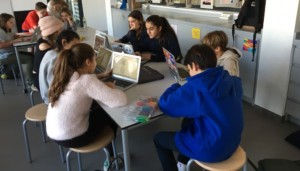Strategies for Tackling Digital Equity

Recent studies from The Pew Research Center, the Schools, Health, and Libraries Coalition, and even Microsoft indicate that a digital divide continues to persist across the country. Though often viewed at a macro level as discrepancies in access between urban and rural communities, news articles from cities ranging from Chattanooga, Tennessee to San Jose, California report lack of sufficient access to high-speed Internet and devices within cities and towns. As early as the late 90s, researchers like Paul Atwell began using the term digital divide to describe the emerging gap between the “information haves and have nots.” In other words, the digital divide is not just about access to devices and the Internet, but about the connection to information, the economy, and broader society.
Thanks to federal programs such as Title I, Title IV, and E-Rate, schools have been able to gain access to both the Internet and devices over the past few decades. The 2018-19 CoSN Infrastructure Survey found that significant gains have been made in connecting schools as 92% report that they have met the minimum bandwidth requirements recommended by the FCC. And yet, despite these efforts, a number of gaps continue to exist based on geography, socioeconomics, status, and race.
By 2016, the National Education Technology Plan addressed the need to consider both technology access as well as a rapidly emerging usage gap. Multiple studies from researchers at the University of South Florida and the University of Southern California have shown that students in less affluent, underserved-communities use technology for remediation and drill-and-practice rather than research, connecting with individuals outside of school, creating new artifacts of learning, and computational thinking.
To further compound the issue, scholars, policy makers, and school leaders must now also address an emerging homework gap. As schools become wired and add devices to classrooms, they must also consider those students who might not have Internet or access to devices at home. A recent survey from the ACT Center for Equity in Learning found that 19% of underserved students reported having access to only a single device–most often a smartphone–and insufficient internet access at home. Further, underserved students compromised a vastly disproportionate share (85%) of the total population of students who reported having access to only one device. When considering the challenges of writing a paper, analyzing data, or even reading extensively, this differentiation of access puts these students at a further disadvantage.
If education leaders hope to ensure equitable education opportunities for ALL students, then they need to consider strategies for providing equitable access to digital learning both inside and outside of school. This means addressing three critical issues: access to the Internet, access to devices, and the digital literacy to understand how to leverage these tools. Therefore, one way forward is to consider a three-pronged approach: resources, community, and literacy.
Resources
The most recent CoSN Infrastructure survey indicated that only 10% of districts felt that ALL of their students had access to more than a non-shared device when at home. This means that while many digital equity concerns have been addressed inside of school, the challenge persists once students go home. While many districts across the country have adopted 1:1 technology programs, which does address the challenge of shared-devices at home, that does not account for the millions of students who may not have reliable Internet access.
As highlighted by the CoSN Digital Equity Toolkit, many districts have started to provide WiFi on school busses, hotspots that can be checked out from the school, as well as the creation of district owned and maintained cellular networks. In fact, a bipartisan bill from Senators Whitehouse, Udall, Gardner, and Cortez Masto would allow districts to use E-Rate funding to pay for WiFi on school busses. Further, programs such as Tech Goes Home, the Verizon Innovative Learning Schools, the Sprint 1Million Project, and T-Mobile for Education’s EmpowerEd can help to fund district initiatives and bring both devices and Internet access to students.
Community Action
However, what if districts do not have the funding – or the internal resources – to support the deployment of WiFi hotspots? Another option to consider is seeking out partnerships with other organizations in the community that may already have WiFi available for students outside of school. Public libraries in cities such as New York and Pittsburgh offer free access to computers, the Internet, printing, and even laptops with hotspots that can be checked out. Faith-based organizations, YMCAs, Jewish Community Centers, and Boys/Girls Clubs have also started offering both access to devices and support in learning how to use them. Most important, many local businesses are willing to allow students to use their WiFi to complete their homework.
The Beaverton School District in Oregon created a community map for students to show which local businesses would support them with free WiFI. Each business then displayed a sign in the window indication that students are welcome. By creating these sorts of partnerships, students not only gain access but also a sense of support from individuals outside of the school community.
Digital Literacy
Most important, with or without devices and consistent Internet access, districts can support the development of digital literacy skills with students, teachers, and families. Particularly in underserved communities, parents may not have the digital literacy skills to help their children navigate the complexities of a technology-rich world. Schools and community organizations can offer support and lessons in addition to access.
For example, Omaha Public Schools launched a mobile learning unit within some of their high-poverty neighborhoods. They wanted to go beyond just offering access and help families develop the digital literacy skills required for today’s economy and society. In a similar vein, Peer-to-Peer University offers recommendations and support to help organizations create learning circles. Whether hosted in a school, a public library, or a local business, participants in a learning circle complete a free online course with the support of in-person peers.
Each district might approach the issue of digital equity from a different perspective, and there is no single best solution. However, to ensure educational equity, districts do need to consider how they can best support their students both inside and outside of the classroom.
For more, see:
- 10 Strategies Promoting Digital Access and Equity
- Closing the Digital Divide to Ensure the Future of Learning
- Inequity in Education is Your (and My) Responsibility
Stay in-the-know with innovations in learning by signing up for the weekly Smart Update.






0 Comments
Leave a Comment
Your email address will not be published. All fields are required.